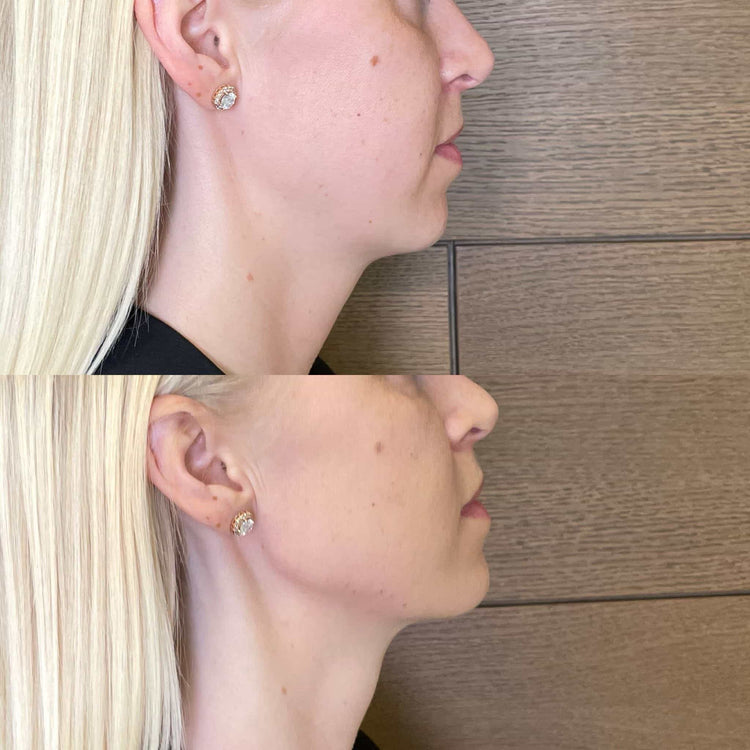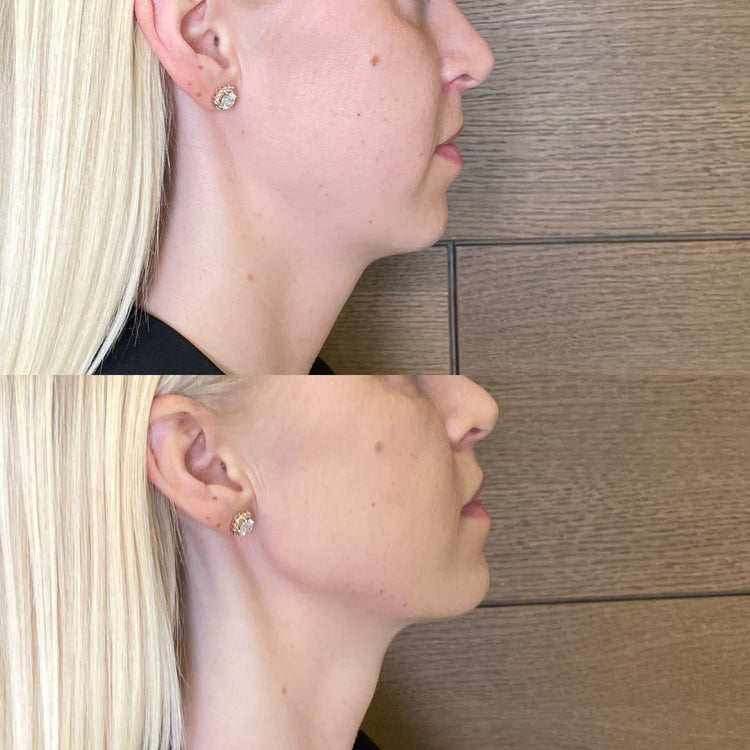Jaw Fillers

The desire for a sculpted and defined jawline has become increasingly popular, leading many to explore facial fillers as a non-surgical solution. Jaw fillers specifically target the lower jaw area to create a more prominent, chiseled appearance. However, they are often confused with chin fillers, which address a different area altogether. Understanding the distinctions between these two types of fillers is crucial for anyone considering this cosmetic enhancement.
What are Jaw Fillers?
Jaw fillers are injectable dermal fillers used to enhance and sculpt the jawline. They add volume to the lower jaw, creating a more defined and angular appearance. Jaw fillers can help improve facial symmetry, contouring, and create a more prominent chin projection.
Purpose of Jaw Fillers
Jaw fillers are designed specifically to address the contours of the lower jaw. Their purpose is to add volume and definition to this area, resulting in a more sculpted and chiseled appearance. Jaw fillers can help create a stronger, more defined jawline, which can contribute to a more balanced and harmonious facial profile.
Types of Jaw Filler Materials
There are several types of materials used in jaw fillers. Hyaluronic acid is the most common type, known for its ability to attract and retain water, providing long-lasting volume. Poly-L-lactic acid (PLLA) is another option that stimulates collagen production, gradually increasing volume over time.
Calcium hydroxylapatite is a biocompatible material that provides immediate volume enhancement and can last longer than hyaluronic acid fillers. Silicone-based fillers are also available but are less commonly used due to potential complications.
Benefits of Jaw Fillers
Jaw fillers are injectable dermal fillers used to enhance and sculpt the jawline. They add volume to the lower jaw, creating a more defined and angular appearance. Jaw fillers can help improve facial symmetry, contouring, and create a more prominent chin projection.
Benefits of Jaw Fillers:
- Enhance Jaw Definition
- Improve Facial Symmetry
- Contour the Lower Face
- Create a More Prominent Chin Projection
- Non-Surgical Procedure
- Relatively Quick and Easy Treatment
- Minimal Downtime
Risks and Side Effects of Jaw Fillers

Like any medical procedure, jaw fillers carry potential risks and side effects. It’s important to understand these before making a decision.
Common side effects of jaw fillers are usually mild and temporary. They may include swelling, bruising, redness, tenderness, and itching at the injection site. These side effects typically subside within a few days to weeks.
More serious complications, although less common, can occur. These include infection, allergic reactions, asymmetry, lumps or bumps, vascular occlusion (blockage of blood vessels), and filler migration (movement of the filler to unintended areas).

It’s crucial to choose a qualified and experienced injector who will assess your individual needs and medical history. Following their pre- and post-treatment instructions carefully can help minimize risks and optimize results.
Chin Fillers
Chin fillers are a type of dermal filler designed to enhance and shape the chin. They add volume to the area below the lower lip, creating a more defined and prominent appearance. Unlike jaw fillers which address the contours of the jawline, chin fillers specifically target the chin region.
What are Chin Fillers?
Chin fillers are injectable substances used to augment and reshape the chin. These fillers are designed to add volume beneath the lower lip, resulting in a more defined and prominent chin. Unlike jaw fillers that focus on sculpting the jawline, chin fillers specifically address the shape and projection of the chin.
Chin fillers come in various formulations, with hyaluronic acid being the most prevalent. Hyaluronic acid is a naturally occurring substance in the body that attracts and retains water, providing volume and hydration to the skin. Other types of chin fillers include poly-L-lactic acid (PLLA) and calcium hydroxylapatite.
Chin fillers can address a range of aesthetic concerns, including a receding chin, a weak or undefined chin, and an imbalance between the chin and other facial features.
Purpose of Chin Fillers
Chin fillers are injectable dermal fillers used to augment and reshape the chin. They add volume beneath the lower lip, creating a more defined and prominent appearance. Unlike jaw fillers which focus on sculpting the jawline, chin fillers specifically address the shape and projection of the chin.
The purpose of chin fillers is to enhance the appearance of the chin by adding volume and definition. This can help create a more balanced and harmonious facial profile. Chin fillers can also be used to correct aesthetic concerns such as a receding chin or an imbalance between the chin and other facial features.
Types of Chin Filler Materials
Chin fillers are injectable dermal fillers designed to enhance and reshape the chin. They add volume beneath the lower lip, creating a more defined and prominent appearance. Unlike jaw fillers which focus on sculpting the jawline, chin fillers specifically address the shape and projection of the chin.
Chin fillers come in various formulations, with hyaluronic acid being the most prevalent. Hyaluronic acid is a naturally occurring substance in the body that attracts and retains water, providing volume and hydration to the skin. Other types of chin fillers include poly-L-lactic acid (PLLA) and calcium hydroxylapatite.
The purpose of chin fillers is to enhance the appearance of the chin by adding volume and definition. This can help create a more balanced and harmonious facial profile. Chin fillers can also be used to correct aesthetic concerns such as a receding chin or an imbalance between the chin and other facial features.
Benefits of Chin Fillers
Chin fillers are injectable dermal fillers designed to enhance and reshape the chin. They add volume beneath the lower lip, creating a more defined and prominent appearance. Unlike jaw fillers which focus on sculpting the jawline, chin fillers specifically address the shape and projection of the chin.
Benefits of Chin Fillers:
- Enhance Chin Definition
- Improve Facial Balance and Proportion
- Correct Receding or Weak Chins
- Create a More Defined Jawline Appearance
- Non-Surgical Procedure
- Relatively Quick and Easy Treatment
- Minimal Downtime
Risks and Side Effects of Chin Fillers
Chin fillers are injectable dermal fillers designed to enhance and reshape the chin. They add volume beneath the lower lip, creating a more defined and prominent appearance.
Like any medical procedure, chin fillers carry potential risks and side effects. It’s important to understand these before making a decision.
Common side effects of chin fillers are usually mild and temporary. They may include swelling, bruising, redness, tenderness, and itching at the injection site. These side effects typically subside within a few days to weeks.
More serious complications, although less common, can occur. These include infection, allergic reactions, asymmetry, lumps or bumps, vascular occlusion (blockage of blood vessels), and filler migration (movement of the filler to unintended areas).
It’s crucial to choose a qualified and experienced injector who will assess your individual needs and medical history. Following their pre- and post-treatment instructions carefully can help minimize risks and optimize results.
Jaw Fillers vs. Chin Fillers: Key Differences
Jaw fillers and chin fillers are both injectable dermal fillers used to enhance facial aesthetics, but they target different areas. Jaw fillers focus on sculpting the lower jawline, creating a more defined and angular appearance, while chin fillers specifically address the shape and projection of the chin.
Filler Placement and Effect
Jaw fillers and chin fillers are both injectable dermal fillers used to enhance facial aesthetics, but they target different areas. Jaw fillers focus on sculpting the lower jawline, creating a more defined and angular appearance, while chin fillers specifically address the shape and projection of the chin.
Jaw fillers are injected into the jawbone area, adding volume and definition to the angle of the jaw. This can create a more prominent and chiseled appearance, improving facial symmetry and contouring. Chin fillers, on the other hand, are placed beneath the lower lip, adding volume to the chin itself.
The placement of these fillers directly impacts their effects. Jaw filler placement alters the lower jaw’s shape and projection, influencing the entire profile. Chin filler placement focuses on enhancing the chin’s prominence, which in turn affects the balance between the chin, lips, and jawline.
Desired Outcome and Aesthetics
Jaw fillers and chin fillers are both injectable dermal fillers used to enhance facial aesthetics, but they target different areas. Jaw fillers focus on sculpting the lower jawline, creating a more defined and angular appearance, while chin fillers specifically address the shape and projection of the chin.
Jaw fillers are injected into the jawbone area, adding volume and definition to the angle of the jaw. This can create a more prominent and chiseled appearance, improving facial symmetry and contouring. Chin fillers, on the other hand, are placed beneath the lower lip, adding volume to the chin itself.
The placement of these fillers directly impacts their effects. Jaw filler placement alters the lower jaw’s shape and projection, influencing the entire profile. Chin filler placement focuses on enhancing the chin’s prominence, which in turn affects the balance between the chin, lips, and jawline.
Ultimately, the choice between jaw fillers and chin fillers depends on the individual’s desired outcome and aesthetic goals. Someone seeking a more sculpted and defined jawline would benefit from jaw fillers, while someone looking to enhance chin projection and balance facial proportions might prefer chin fillers.
Techniques Used for Injection
Jaw fillers and chin fillers are both dermal fillers used to enhance facial aesthetics, but they target different areas and produce distinct results.
Jaw fillers are designed to sculpt and define the lower jawline. They are injected into the jawbone area to add volume and create a more prominent, angular appearance. This can help improve facial symmetry, contouring, and create a stronger, more defined jawline.
Chin fillers, on the other hand, focus on enhancing the shape and projection of the chin. They are injected beneath the lower lip to add volume and definition to the chin itself. This can help create a more balanced and harmonious facial profile, correct a receding chin, or define the jawline indirectly by creating a better balance between the chin and lips.
The techniques used for injection are similar for both types of fillers. A trained injector will use a fine needle to deposit the filler material into the targeted area. The amount of filler used will depend on the individual’s desired outcome and anatomy.
Enhance your jawline with expert jaw fillers from Dr. Laura Geige at It’s Me & You Clinic
- Jaw Fillers Vs Chin Fillers: Understanding The Differences - October 3, 2025
- How To Incorporate CBD Infused Gummies Into Your Sleep Routine - October 3, 2025
- Jaw Fillers For A Defined Jawline Near Mortlake, Surrey - September 30, 2025

